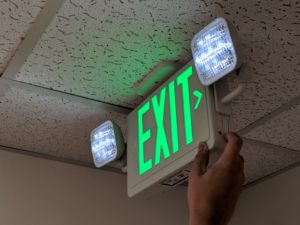Emergency Lighting encompasses Emergency Light Fixtures, Exit Signs, Exit Sign + Light Combos and more. These units often go unnoticed until they are needed. Neglecting your facilities emergency lighting is a decision that could put you in risk of fine, legal action or serious danger for you or your patrons. What rules govern emergency lighting? What should I know post-purchase?
There are a number of regulations or codes that are imposed on Emergency Lights and Exit Signs from various authorities such as OSHA (Occupational Safety and Health Administration) and NFPA (National Fire Protection Association). Additionally, your local jurisdiction may impose their own codes and requirements for emergency lighting. Your local Fire Marshal or Inspector is your go-to resource for understanding these code requirements.
Emergency Lights and Exit Signs are integral pieces of safety equipment in commercial and some multi-tenant residential buildings that provide backup illumination when a building experiences a power outage and illuminate the path to exit. Emergency Lights are specifically designed to operate when the power goes out and are thus different than normal light fixtures that operate when the power is on. In order to function this way, emergency lights and exit signs are equipped with a rechargeable battery that powers the light fixture in “Emergency Mode”. Some units come without a battery, referred to as AC Only. These are most commonly used when a building is already connected to a backup generator system.
The NFPA requirements for Emergency Lighting as found in their Life Safety Code handbook are laid out in detail. Section 7.9. discusses emergency lights and the requirements for illumination (how much light is produced in lumens), placement of light fixtures, and one that is often overlooked by many, Testing Requirements for Emergency Lighting.
With the seriousness of emergency lighting systems, we stress the importance of maintaining these systems. Not only are there legal implications for overlooking the upkeep of these systems, but lives are at stake. In the case of an emergency, the lack of a functioning emergency light system could lead to catastrophic results. Neglecting the required standards can lead to a shut down to your property.
How To Test Emergency Lights and Exit Signs

Self Testing / Self Diagnostic Emergency Lights and Exit Signs are a popular choice for many. These units automate much of the process on their own, eliminating the need for a person to physically test each unit. Instead, a quick walk through to assess the LED status indicators will suffice.
